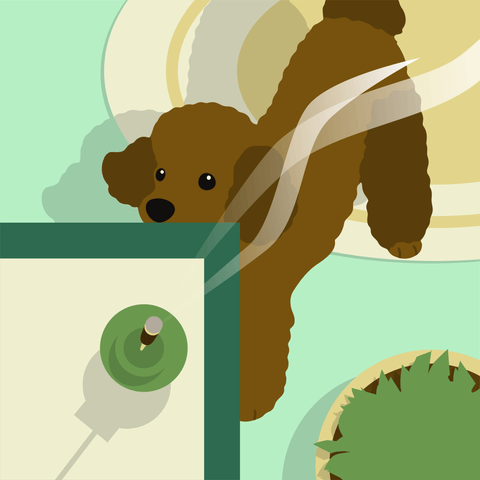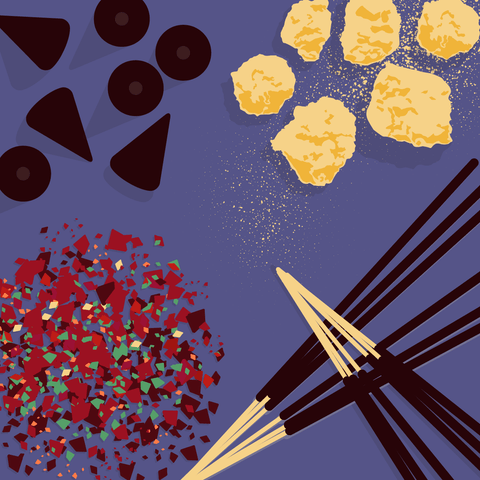Backflow incense cones can be a beautiful and aromatic way to enhance your space. They are unique in that the smoke flows downward, creating a mesmerizing waterfall effect. To achieve this effect, we'll show you how to light and safely burn a backflow incense cone, step by step.
But be warned: there are some significant drawbacks to burning backflow incense cones that we have experienced first-hand. Scroll the last section in this blog for our personal opinion as incense makers on the less than ideal fragrance reality of burning backflow incense cones.
What you will need to burn a backflow incense cone:
- A backflow incense cone
- A backflow incense burner
- Lighter or matches
- A heat resistant surface to place the burner on
- A well ventilated, draft free space
What is a backflow incense cone?
Backflow incense cones have a hole drilled into the bottom of the incense cone. If placed on a regular incense cone burner, the backflow incense cone will produce smoke from the top of the cone, just like a regular incense cone.
When placed on an incense burner specifically for backflow incense cones, the smoke will also cascade from the bottom of the incense cone. This waterfall effect is very soothing and delightful to observe.
Step 1: Use a backflow incense cone burner
To experience the unique cascading smoke effect, you must use a backflow incense cone burner.
These specially designed incense burners have a hole at the base where the cone sits, allowing the smoke to flow downward.
Step 2: Place the incense cone properly
Position the backflow incense cone upright on the burner, making sure to cover the hole. This alignment is essential to achieve the signature incense smoke waterfall effect.
Step 3: Light the incense cone
Ignite the tip of the incense cone with a lighter or matches. Be sure the backflow burner is in a well ventilated room, but away from drafts or breezes. Air movement will interfere with the cascading smoke effect.
Step 4: Let it burn briefly
Allow the flame to burn for about 5–10 seconds to make sure the cone will continue to burn after the flame is extinguished.
Step 5: Gently blow out the flame
Gently blow out the flame, leaving the tip of the backflow incense cone glowing red. If there is no ember, repeat the lighting process.
Step 6: Check for a glowing ember and ashen tip
If the cone has an ember, blow gently to encourage a steady burn. Ash will start to form at the tip of the backflow cone. If not, you may need to light it again.
Step 7: The calm before the flow
Initially, the smoke will rise from the top like a regular incense cone. Give it a minute or two, and this is when the magic starts. Watch as the smoke begins to drift downward, creating that signature waterfall effect.
No need to rush; the moment is part of the experience.
Step 8: Watch the cascade effect
Soon, you will start to see the smoke begin to cascade down the burner, creating a waterfall effect.
Step 9: Enjoy the waterfall effect
The cascading smoke is a beautiful and calming sight, perfect for meditation or relaxation. This effect is unique to backflow cone incense.
Step 10: Beware aware of the end of the burn
Backflow incense cones will emit an acrid smell toward the end of the burn. This is because the base of the cone has become a very hot ember, heating the remaining incense oils to the point where they take on a harsh, burnt odour.
You can carefully extinguish the cone in a sink, but be prepared to clean the sink afterwards as there will be residue.
Step 11: Oily residue and post burn ashes
Backflow incense cones create more clean up than incense sticks or regular incense cones. They leave behind more ashes, and as they absorb more oil, they also leave behind a harsh smelling burnt oil residue.
Much like the smoke, the burnt oil will also pour down the backflow burner and coat it in an acrid sticky residue.
Step 12: Proper backflow cone burner cleaning
It is important to clean the backflow incense cone burner after each use to reduce the burnt oil smell and keep the burner looking clean and attractive. This will keep your burner in good condition and enhance your experience.
Ensure the burner is thoroughly cleaned between burns to remove any residual oils and ash. Use a toothbrush and dish soap to remove the sticky oil residue.
Tips & Troubleshooting for Burning Backflow Incense Cones:
1. No waterfall effect
Make sure you’re using a true backflow incense cone, not a regular cone. Backflow cones have a small hole in the bottom that aligns with the hole in your backflow burner—this creates the downward smoke effect.
Also, check that your burner is sitting on a flat, heat resistant surface, and try to be still. Your movements can create air movement, and this can impact the smoke waterfall.
2. The cone will not stay lit
Hold the flame to the tip of the cone for at least 10–15 seconds. Some cones need a little longer to catch. Once lit, let the tip glow for a few seconds before blowing out the flame gently.
3. Smoke is going up instead of down
This often happens if the cone isn't properly aligned over the hole in the backflow incense burner. Try repositioning it so the base of the cone seals tightly around the hole.
You have to let the cone burn for a bit before the smoke will start coming from the bottom, so be patient.
4. Smoke flow is weak
While you should always burn incense in a well ventilated space, a draft can impact the ability for a backflow incense cone to create the smoke waterfall effect.
But wait, why don't you sell backflow incense cones?
We think that backflow incense cones do a terrible job at carrying incense fragrance, and in the wise words of Floré’s founder, they are “just a fad”.
We did try making and selling backflow incense cones in 2024 and we discontinued the lineup in 2025 due to poor sales and our own personal dislike for the product itself. If we do not believe in the product or want to use it personally, we will not continue to sell it. Luckily the sales were so unimpressive that this was an easy decision for us to make.
Incense cones in general absorb more oils and burn hotter than incense sticks. Backflow incense cones burn even hotter as they have increased airflow due to the hole drilled in the bottom. If the fragrance oils and cone itself are of high quality, which ours were, the scent is delightful when the cone initially starts to burn.
However, as the backflow incense cone continues to burn, the oils will start to leach out of the cone and pool at the base. The ember is very hot and will start to burn the excess oils as opposed to just dispersing them in the smoke, which incense sticks are so much better at accomplishing.
The burnt oil has a horrible, very acrid smell that begins to coat the incense burner. We would never make it through an entire backflow incense cone burn without extinguishing the cone due to the terrible smell that would usually start when the cone was only ⅔’s of the way through burning.
The backflow incense cone burner would be an absolute mess after only one burn. The sticky, horrible smelling burnt oil had to be cleaned off after each use, otherwise the acrid scent would start to happen as soon as the waterfall smoke effect would begin.
For these reasons, we feel that if you want to truly enjoy the fragrance of incense, incense sticks are the most enjoyable and satisfying incense to burn.
Written by Flo Ray





